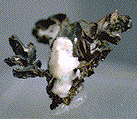
- Chemistry: Mn, elemental manganese
- Class: Elements
- Uses: Many applications for manganese.
Specimens
Manganese is named from a corruption of the latin word for magnestism; magnes, in allusion to its prinicple ore's magnetic properties. However, manganese crystals have yet to be found in nature and therefore it is technically not a mineral, although laboratory grown specimens can look like a natural stone.
The element manganese is an essential element in people's daily food consumption and has several industrial uses. Manganese is used in steel alloys to increase many favorable characteristics such as strength, hardness and durability. In fact steel can not be produced without manganese; it is an essential ingredient in the process. Manganese is also used to color glass an amethyst color. That is not so surprising since manganese is the trace element responsible for quartz's purple variety, amethyst.
Manganese coloring ability in minerals is well known and appreciated. Manganese is chiefly responsible for the wonderful colors in rhodochrosite, purpurite, rhodonite, serandite and spessartine to name a few. Unfortunately most manganese oxide minerals tend to be black. Manganese is extracted from the ore minerals pyrolusite and rhodochrosite. Manganese nodules on the sea floor may one day provide an economic source as well.
PHYSICAL CHARACTERISTICS:
- Color is steel or silver grey.
- Luster is metallic.
- Transparency: Specimens are opaque.
- Crystal System is isometric.
- Crystal Habits include only lab grown specimens.
- Specific Gravity is 7.44 (very heavy for a metallic mineral).
- Notable Occurrences include only lab grown specimens.
- Best Field Indicators are color and density.







